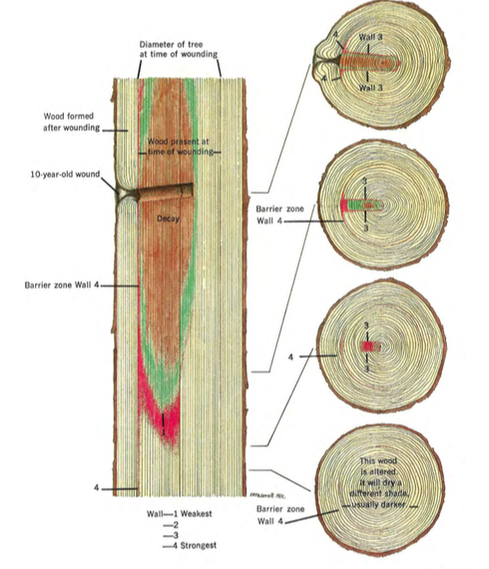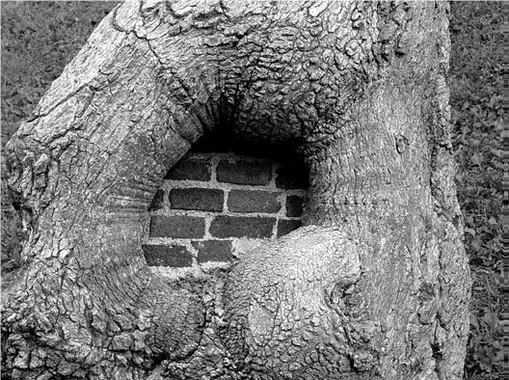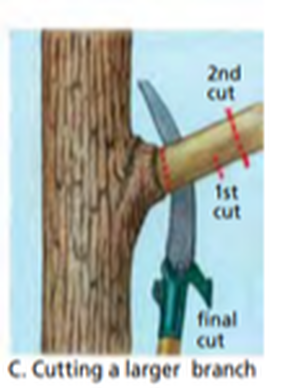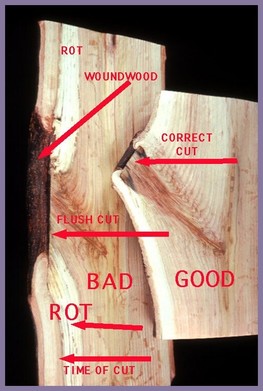To cover, or not to cover, that is the question of tree wound care
Authored by Nick Sanders
 Figure 1. An example of a product that
is available for tree wound cover (1).
Figure 1. An example of a product that
is available for tree wound cover (1).
The misconception on whether to cover the wound of a tree has long been a topic of discussion, thankfully there has been a lot of research conducted to tell us whether covering the wound of a tree is actually beneficial. The misconception that covering a tree wound is beneficial and facilitates faster tree “healing” may have become common if people believe that tree bark is similar to human skin. However, trees do not heal in the same way animals heal, trees grow new tissue over a wound – but the wound remains for the life of the tree. Trees go through a compartmentalization process, which will be explained in detail. The need to cover wounds is perpetuated through the sale of products, such as in
Figure 1, advertised to heal and prevent decay in the wounds.
Figure 1, advertised to heal and prevent decay in the wounds.
In this web page we will also look at the negatives of covering a wound and what happens to the tissues that surround the wound and the tree when this is done. Then we will look at the process of Compartmentalization of Decay in Trees, or CODIT, the natural process that begins sealing off the wound of a tree. Detailed information will be provided on the proper pruning methods that should be utilized to help the tree seal off the wound and cause the least amount of damage to the area surrounding the wound, removing a need for any covering.
Effects of Wound Covering
When covering a wound of a tree many things can begin to happen. Due to common misconception, it is sometimes thought that covering a wound will help to protect the tree and keep pathogens out, such as what was done in Figure 2. However, it is in fact the opposite effect that takes place, often covering the wound creates a sort of micro climate underneath the covering (2,3,5,7). Examples of common materials used to cover wounds include tar, paint, wax, and even cement for cavity filling. These all have similar negative effects and do not help the tree in its recovery process (8). The covering keeps in moisture and keeps it protected, creating a perfect environment for fungi or other organisms to thrive. This will lead to an increase in the amount of stress the tree is under, which could lead to the death of the tree (2,3,5,7). However, it was found in one study that covering a wound with Polyethylene Plastic Wrap can increase wound closure. But it was only found to be effective on Aspen and Maple trees when the wound was covered for one week or less (11).
Internal wound response
 Figure 3. Four walls of CODIT and their locations within a tree (3).
Figure 3. Four walls of CODIT and their locations within a tree (3).
After a tree has been wounded there are a series of events that take place in order to begin the process of sealing off the wound and preventing any potential spread of disease. The internal process of wound response that the tree uses is called CODIT. This system consists of four barriers or “walls” used in a line of defense that help to seal off the wound from the rest of the tree, shown in Figure 3. Wall one, which is the weakest of the four walls is used to seal off the vertical vascular system, which is what moves water and nutrients up and down the tree, both above and below the wound, this can be done with gums or resins. Wall two is a tangential wall that prevents the movement of decay inward toward the center, or pith, of the tree. Except for where ray cells, which are cells that allow for radial transport of sap, pass through, this wall is continuously formed by the last cells of each growth ring. The third wall, composed of ray cells, inhibits movement of decay in a radial direction. The fourth and final wall is a newly formed protective layer that is produced by the cambium, which is what produces a new growth ring each year. The main function of this wall is to act as a vault door and keeps the wound material separated from the new growth. This is the strongest wall of the four, due to its thick-walled cells and the chemical make-up of the wall (9). This process is used by the tree whether it has been wounded through intentional purposes such as pruning and unintentional wounding such as hitting the tree with a mower or line trimmer.
Pruning Wounding
Pruning is an important part of tree care, but knowing how to prune correctly is important when it comes time for the tree to recover from pruning wounds and removing a need for any sort of covering. Determining where to cut a branch can be difficult as growth and development varies by species but in the case where the branch has a collar of growth at the base of it, you would want to make your cut on the outside edge of the collar. If you cut into the collar or make a flush cut you will be cutting into the vertical vascular system of the main trunk, shown in Figure 5. This will adversely affect the tree and cause more damage than intended. By cutting into the vascular system of the main trunk you are affecting the tree’s ability to move water and mineral nutrients in that location which can cause damage above the initial wound. While damaging the vascular system it also creates a wound that is much larger and more difficult for the tree to compartmentalize (8). A good pruning practice is to use the three-cut method shown in Figure 4, this process follows the guidelines for proper cutting position. This also ensures that when the branch falls it does not tear any bark off the main trunk from the bottom of the cut and prevents any need to cover the wound (10).
Recommendation
This can be a difficult topic to address due to the science and logistics behind the right answer to this long believed misconception. But with the help of research that has been tested and completed it shows that the best thing to do with a wound on a tree is simply to let it be. The tree has developed its own mechanisms to cope with wounds and has been working out well for the trees without our help for thousands of years.
Simple procedures that you can follow include:
Simple procedures that you can follow include:
- Avoid creating a wound on your tree
- If you have to make a wound when pruning, do it when the branch is small to create the smallest wound possible while using correct pruning techniques
- Avoid using any type of covering on the wound – simply let it take care of itself
- If you have a cavity seek professional advice to assess the stability of the tree
Summary
Wounds of trees do not simply heal like human skin, a common misconception that has led many to cover a wound with a variety of materials. This in return can lead to further rot and decay instead of being sealed off if it had been left uncovered. Through the process of CODIT, the tree sections off the wounded area and continues growing past it. Knowing how to properly prune branches is another vital component to the wound recovery. While using the three cut pruning method and cutting in the proper place on the branch, the wound will be minimal and the tree will be able to seal it properly. Through correct pruning you will also eliminate any need for unnecessary covering of a wound. With the information provided one can see the fault in this long-believed misconception.
References
1. Lipford, Danny. Treating Cut Tree Limbs with Wound Paint. s.l. : Today's Homeowner, 2018.
2. Tree wounds: Response of trees and what you can do. Clatterbuck, W. K. University of Tennessee, pp. 1-4.
3. Compartmentalization of Decay in Trees. Shigo, A. L. and Marx, H. G. s.l. : Forest Service U.S. Department of Agriculture, 1977, pp. 1-76.
4. Shigo, A. L. A New Tree Biology. s.l. : Shigo and Trees, Associates, 2002.
5. Wound dressings: results of studies over 13 years. Shigo, A. L. and Shortle, W. C. 1983, Journal of Arboriculture, pp. 317-329.
6. Wound healing in higher plants. Bloch, R. s.l. : Botanical Review, Vol. 7, pp. 110-146.
7. Wound protection on deciduous fruit trees. Dye, M. H. s.l. : Journal of Agricultural Research, 1971, Vol. 12, pp. 526-534.
8. The Hamburg Tree Pruning System - A framework for pruning of individual trees. Dujesiefken, D and Stobbe, H. s.l. : Urban Forestry and Urban Greening, 2002, pp. 1-8.
9. Compartmentalization Of Decay In Trees. Fraedrich, B. R. s.l. : Bartlett Tree Research Laboratories, 2018.
10. How to Prune Trees. Bedker, Peter J., O'Brien, Joseph G. and Mielke, Manfred E. s.l. : USDA, 2012, pp. 1-32.
11. Polyethylene Plastic Wrap For Tree Wounds: A Promoter of Wound Closure on Fresh Wounds. McDougall, Dennis N. and Blanchette, Robert A. 1996, Journal of Arboriculture, Vol. 22, pp. 1-5.
1. Lipford, Danny. Treating Cut Tree Limbs with Wound Paint. s.l. : Today's Homeowner, 2018.
2. Tree wounds: Response of trees and what you can do. Clatterbuck, W. K. University of Tennessee, pp. 1-4.
3. Compartmentalization of Decay in Trees. Shigo, A. L. and Marx, H. G. s.l. : Forest Service U.S. Department of Agriculture, 1977, pp. 1-76.
4. Shigo, A. L. A New Tree Biology. s.l. : Shigo and Trees, Associates, 2002.
5. Wound dressings: results of studies over 13 years. Shigo, A. L. and Shortle, W. C. 1983, Journal of Arboriculture, pp. 317-329.
6. Wound healing in higher plants. Bloch, R. s.l. : Botanical Review, Vol. 7, pp. 110-146.
7. Wound protection on deciduous fruit trees. Dye, M. H. s.l. : Journal of Agricultural Research, 1971, Vol. 12, pp. 526-534.
8. The Hamburg Tree Pruning System - A framework for pruning of individual trees. Dujesiefken, D and Stobbe, H. s.l. : Urban Forestry and Urban Greening, 2002, pp. 1-8.
9. Compartmentalization Of Decay In Trees. Fraedrich, B. R. s.l. : Bartlett Tree Research Laboratories, 2018.
10. How to Prune Trees. Bedker, Peter J., O'Brien, Joseph G. and Mielke, Manfred E. s.l. : USDA, 2012, pp. 1-32.
11. Polyethylene Plastic Wrap For Tree Wounds: A Promoter of Wound Closure on Fresh Wounds. McDougall, Dennis N. and Blanchette, Robert A. 1996, Journal of Arboriculture, Vol. 22, pp. 1-5.




